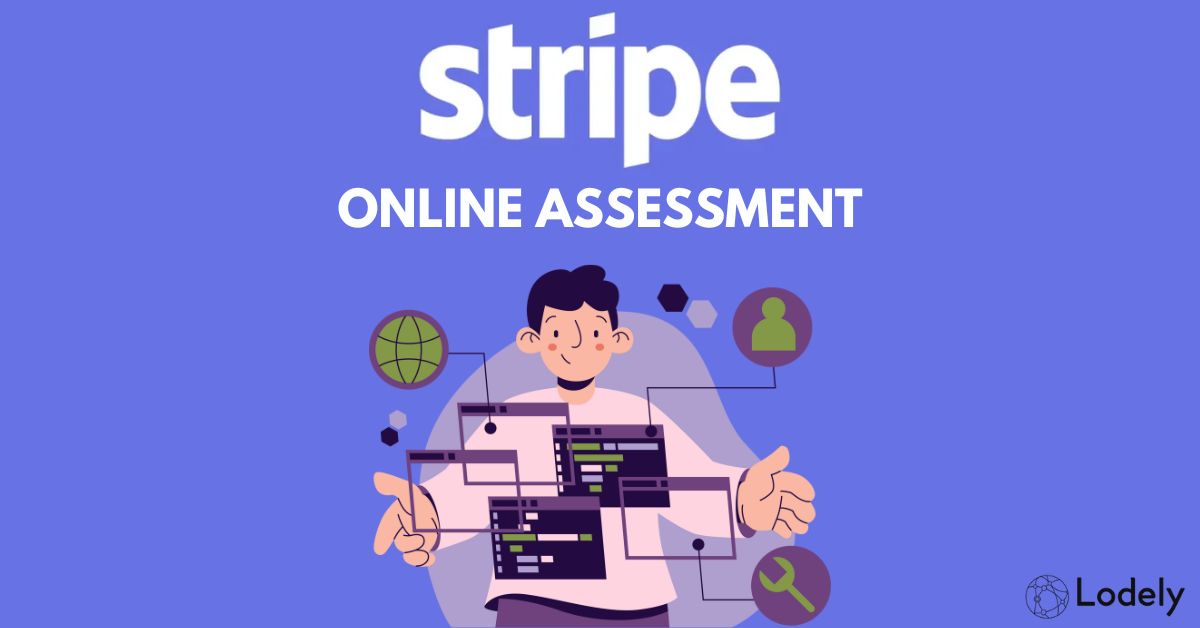Stripe Online Assessment 2025: Questions Breakdown and Prep Guide

Stripe processed over $1.4 trillion in payment volume last year and continues to expand its global engineering teams, making its online assessment one of the most competitive gateways in tech.
Thousands of applicants take it each year, but only a small percentage move forward.
If you’ve been practicing on LeetCode or CodeSignal but still aren’t sure what Stripe actually looks for, this guide is for you.
We’ll break down how the assessment works, the common question types in 2025, and the best ways to prepare so you can walk in confident and ready.
What Does Stripe’s Online Assessment Look Like?

If you’ve just applied to Stripe or spoken with a recruiter, the next step is usually the Online Assessment (OA).
It’s a timed coding test that gives Stripe a first look at how you think as an engineer.
When You’ll Receive the Assessment
Candidates typically receive the OA within a week of recruiter contact or application submission.
Once you get the link, you’ll have a few days to complete it before it expires. Recruiters usually confirm the platform, duration, and number of problems in advance.
What the Assessment Includes
The test usually consists of two medium and one hard-level questions that focus on data structures, algorithms, and real-world coding logic.
Common topics include arrays, strings, graphs, recursion, and dynamic programming.
Each problem includes hidden test cases, so your solution must work beyond the visible examples. The environment is timed and sometimes proctored, designed to simulate how you perform under realistic constraints.
After You Submit
Once submitted, your code is automatically scored for correctness, efficiency, and readability.
Stripe engineers or reviewers then assess your solution for clarity, naming conventions, and logical structure.
If you pass, you can expect to hear back from your recruiter within 3–5 business days, moving forward to the live technical interviews.
What Questions Are Asked During Stripe’s Online Assessment?

Here are representative LeetCode problems that closely resemble what candidates report seeing in Stripe’s OA in 2025:
- Find Maximum Revenue Interval — type: Dynamic Programming / Interval Scheduling
- Validate Payment Request Strings — type: Stack / String Parsing
- Large Number Modular Arithmetic — type: Math / Number Theory
- Graph Path Reliability After Node Failures — type: Graph / Dijkstra
- Merge K Sorted Payment Streams — type: Divide & Conquer / Heap
- Detect Cycle in Directed Graph — type: Graph / DFS
- Longest Substring with At Most K Distinct Characters — type: Two Pointers / Sliding Window
- Buy/Sell Stock with K Transactions — type: Dynamic Programming / Optimization
- Iterator for Transaction Logs — type: Iterator / Design Pattern
- Median of Two Sorted Arrays — type: Search / Partition
- String Compression or Encoding Validator — type: String / Stack / Parsing
- Concurrent Task Scheduler — type: Heap / Greedy / Simulation
- Rate Limiter Implementation — type: Queue / HashMap / Sliding Window
- Order Matching Engine Simplification — type: Priority Queue / Sorting / Greedy
1. Find Maximum Revenue Interval
This problem focuses on dynamic programming and interval scheduling — optimizing for the best combination of non-overlapping jobs or tasks.
In Stripe’s context, think of it as maximizing revenue over time while avoiding conflicts between transactions. It tests your ability to combine sorting with dynamic logic and handle overlapping intervals efficiently.
2. Validate Payment Request Strings
A stack and string parsing problem that tests how you handle validation under uncertainty.
The goal is to determine if a string (representing a payment request or nested operation) is valid given a mix of required and optional symbols.
It evaluates logical reasoning, conditional handling, and your ability to translate rules into code.
3. Large Number Modular Arithmetic
This challenge centers on number theory and modular math — key to financial systems that involve hashing, cryptography, or ID verification.
The task is to compute large powers efficiently without overflow, testing your ability to apply modular exponentiation and optimize memory use.
4. Graph Path Reliability After Node Failures
Based on graph traversal and Dijkstra’s algorithm, this problem asks you to find the shortest paths when some nodes fail or slow down.
It simulates a real-world system fault, such as delays in a distributed payments network, and tests your ability to write robust, fault-tolerant logic.
5. Merge K Sorted Payment Streams
This is a divide-and-conquer or heap problem where you merge multiple sorted lists efficiently.
It’s highly relevant to Stripe-like systems that process payments or logs from multiple data streams.
It tests your grasp of heap operations and your approach to optimizing time complexity.
6. Detect Cycle in Directed Graph
A core graph and DFS problem that tests whether you can identify cycles in a dependency structure.
It mirrors challenges in queue management or payment pipelines where circular dependencies must be avoided. The problem checks both your recursive thinking and data flow awareness.
7. Longest Substring with At Most K Distinct Characters
This two-pointer and sliding window problem focuses on managing dynamic constraints efficiently.
It tests how you balance space and time complexity while tracking real-time data. Stripe might use similar logic in rate limiting or user activity tracking.
8. Optimize Payment Batching with K Transfers
A dynamic programming problem that involves maximizing profit or minimizing loss under a limited number of transactions.
It closely resembles optimizing payment batches — how to group transfers efficiently while minimizing cost. This tests your ability to identify state transitions and cumulative optimization.
9. Log Stream Iterator for Payment Events
This problem uses iterators and design patterns to simulate traversing through nested data, such as payment or event logs.
It checks your ability to design structured, reusable code that handles unpredictable nesting — a common task in Stripe’s data systems.
10. Median of Two Sorted Arrays
This classic search and partition problem is about finding the median efficiently without merging full datasets.
It’s conceptually similar to analytics or reporting systems that combine data from different sources. The challenge lies in dividing and conquering with precise index logic.
11. String Compression or Encoding Validator
A stack and parsing problem involving decoding or validating encoded input strings.
It represents real-world use cases such as interpreting compressed payment payloads or decoding structured data formats.
It tests recursion, stack logic, and your ability to handle nested structures.
12. Payment Queue Scheduling Logic
This heap and greedy challenge revolves around scheduling tasks while minimizing idle time.
It reflects real-world queuing in transaction systems, where you must balance throughput and efficiency under specific constraints.
It tests prioritization logic and time-based optimization.
13. Rate Limiter Implementation
This queue and hashmap problem simulates rate limiting — how to control the number of requests within a given time frame.
It’s a practical exercise for backend or API engineers, testing your ability to design time-based logic with rolling windows and efficient data cleanup.
14. Order Matching Engine Simplification
A priority queue and greedy problem that models a simplified order-matching engine, much like transaction pairing in fintech. It tests how you handle large data volumes, balance trade-offs, and maintain state consistently across operations.
Each of these problems mirrors Stripe’s emphasis on clarity, structure, and problem-solving under real-world constraints.
Tips to Pass Stripe’s Online Assessment

Preparing for Stripe’s Online Assessment is more than just solving problems. It’s about showing how you think, structure your code, and stay composed under pressure.
Train in the exact environment
Practice on CodeSignal/HackerRank in 90-minute blocks with 2–3 problems, no autocomplete, and your usual language. Recreate test friction (single monitor, timer, no notes). Do at least 3 full simulations before the real OA.
Master the core patterns Stripe actually asks
Don’t scatter your prep across random LeetCode problems. Focus instead on the recurring patterns that Stripe consistently tests:
- Sliding Window
- Heaps / Priority Queues
- Graphs (BFS, Dijkstra)
- Dynamic Programming (intervals, optimization)
- String Parsing with Stacks
Pick one representative question per pattern and rehearse it from memory until you can explain every line of your approach.
Write like someone else will extend your code tomorrow
Stripe reviewers score clarity: descriptive names, small functions, early returns, and brief top-of-file comments outlining the approach and complexity.
Handle edge cases up front (empty input, single element, large values) before optimizing.
Optimize your scoring strategy
Aim to fully solve two problems first. On the hardest one, land a clean O(n log n)/O(n) solution that passes visible tests, then tighten.
Add a quick custom test after each pass (min/max inputs, duplicates, sorted/unsorted) to avoid hidden-case failures.
Use a strict pacing plan
Spend 25–30 minutes on Problem 1 (start easy to build flow).
- Dedicate 35–40 minutes to Problem 2 (the main scoring weight).
- Use the remaining time for Problem 3 (aim for partial points).
- If stuck beyond 7 minutes, pivot or move forward.
Leave 3–5 minutes at the end to review, handle edge cases, and comment your complexity.
Conclusion
Stripe’s Online Assessment goes beyond testing correctness. The key isn’t endless practice but intentional preparation that sharpens both your logic and clarity.
For more practical insights and prep strategies, explore the Lodely Blog or start from Lodely’s homepage to find guides and career resources tailored to software engineers.
You can also check out our breakdowns of the CodeSignal GCA and the DoorDash Code Craft Interview to get a better feel for how other companies structure their assessments.
If you’re serious about landing a top-tier offer, consider working with a Software Engineering Career Coach to build a study plan that fits your level, goals, and schedule.
Prepare with focus, write with intent, and treat Stripe’s OA as your first chance to show how you solve problems that matter.
FAQs
How long is the Stripe Online Assessment?
The Stripe Online Assessment typically lasts 90 minutes, giving you enough time to solve 2–3 coding problems under timed conditions.
What platform does Stripe use for its OA?
Stripe usually conducts its OA on CodeSignal or HackerRank, depending on the role and location.
How many questions are in Stripe’s OA?
Most candidates receive two medium and one hard-level question, covering algorithms, data structures, and clean coding practices.
Can I use an IDE during Stripe’s OA?
You’ll code directly within the test platform’s built-in editor. External IDEs or autocomplete tools are generally not allowed.
How is the Stripe OA scored?
Your submission is graded on correctness, efficiency, and code clarity, with extra credit for handling edge cases and writing readable, modular logic.




%2C%20Color%3DOriginal.png)



